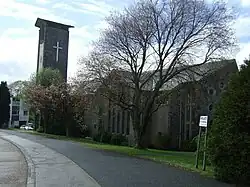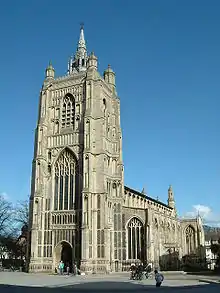Robert Potter | |
|---|---|
| Born | 6 October 1909 Guildford, Surrey |
| Died | 30 November 2010 (aged 101) |
| Alma mater | Regent Street Polytechnic |
| Occupation | Architect |
| Awards | OBE |
| Practice | Brandt, Potter, Hare |
| Buildings | |
| Projects | |
Robert James Potter OBE (6 October 1909 – 30 November 2010) was an English architect who was noted for his work on church buildings.[1][2][3] He studied architecture in London before moving to Salisbury where he established his practice.
Early life and education
Potter was born in Guildford, Surrey to Jack Potter, an engraver who worked on printing blocks for Bank of England banknotes, and his wife Florence.[1] After school he studied Architecture at the Regent Street Polytechnic.[1]
Career
Potter moved to Salisbury in 1935, aged 26, establishing an architectural practice there. Within three years he was commissioned to design St Francis's Church in the city, which has subsequently become a listed building.
In the Second World War he served in the Royal Engineers in northern India where he was involved in constructing road and rail networks to enable troop movements to the war in the Far East. He attained the rank of lieutenant-colonel during his wartime service.[1]
After the war he returned to Salisbury and began a professional partnership with William Randoll Blacking, who had studied under Sir Ninian Comper and was known for his design and conservation work on ecclesiastical buildings. Their partnership lasted 11 years, after which Potter established his own firm with a new partner, Richard Hare, based in De Vaux House in Salisbury.[1]
Potter's designs included military and residential buildings (such as the extensive extension to South Stoneham House in Southampton) but his primary focus was on church architecture; in 1958 his Church of the Ascension, Crownhill in Plymouth was consecrated and in 1959 he started work on St George's, in Oakdale, Poole. Potter's practice expanded in 1967, being renamed the Brandt, Potter, Hare Partnership and opening an office in Southampton.[1]
Potter's work was not purely on new builds. He was involved in substantial renovation works to a number of well known buildings including Chichester Cathedral, Oxford's Bodleian Library, St Peter Mancroft (the largest church building in Norwich other than the city's cathedrals) and St Stephen Walbrook, All Souls Church, Langham Place and St Paul's Cathedral, all in central London.[1] He became well known for creating community rooms under the foundations of ancient church buildings and earned the nickname "The Mole" as a result.[2] In addition to his work on the buildings themselves, Potter was noted for his designs of fixtures and fittings including organs, crosses, candlesticks and fonts.[2]
From 1978 to 1984, he was Surveyor of the Fabric of St Paul's Cathedral.
In 1989 Potter's designs were used to extend the St Edward the Confessor Roman Catholic Church in Chandler's Ford, Hampshire, where the original building had been designed by Potter's first professional partner, William Randoll Blacking.[4]
Potter was awarded the OBE in 1993.[1]
Personal life
Potter married Geraldine Buchanan when he moved to Salisbury in 1935. They had three children together but divorced in the early 1960s. He married again to Margaret and had two stepchildren. He enjoyed watercolour painting and sailing, having obtained a master mariner's certificate.[1]
Notable works
Notable buildings that Potter designed or worked on include:
| Year | Building | Image | Location | Potter's role | Building status |
|---|---|---|---|---|---|
| 1938 | St Francis Church Salisbury[1] |  | Salisbury, Wiltshire | Architect | Grade II listed |
| 1955–1977 | Chichester Cathedral[1] |  | Chichester, West Sussex | Assisted with renovation; established masons' workshop | Grade I listed |
| 1958 | Church of the Ascension, Crownhill[1] |  | Crownhill, Plymouth, Devon | Architect | Grade II listed[5] |
| 1960 | St George's Church[1] |  | Oakdale, Poole, Dorset | Architect | Grade II listed[6] |
| 1960s | St Peter Mancroft[3] |  | Norwich, Norfolk | Architect (roof replacement) | Grade I listed[7] |
| 1964 | South Stoneham House[8] |  | Swaythling, Southampton | Architect of major extension including 17-storey tower block | Demolished.
The original Grade II* listed manor house still stands. |
| 1967 | All Saints Clifton[9] |  | Clifton, Bristol | Architect (rebuilding) | Grade II listed[10] |
| 1970s | St Paul's Cathedral[1] |  | City of London, London | Surveyor to the Fabric | Grade I listed |
| 1976 | Lincoln College Library (formerly All Saints Church)[11] |  | Oxford, Oxfordshire | Conversion of church building into library | Grade I listed |
| 1988 | St Andrew's Church, Goldsworth Park[12] | _(2).JPG.webp) | Goldsworth Park, Woking, Surrey | Architect | – |
| 1989 | Church of St Edward the Confessor, Chandler's Ford[4] |  | Chandler's Ford, Hampshire | Architect (extension) | |
| Unknown | Bodleian Library[1] |  | Oxford, Oxfordshire | Architect (structural reinforcements) | Grade I listed |
| Unknown | St Stephen Walbrook[1] |  | City of London, London | Architect (renovations/repairs) | Grade I listed |
| Unknown | All Souls Church, Langham Place[1] |  | Marylebone, London | Architect (renovations/repairs) | Grade I listed[13] |
| Unknown | St Matthew's Church, Bridgemary[14] | _(6).JPG.webp) | Bridgemary, Gosport, Hampshire | Architect (with Richard Hare) | |
References
- 1 2 3 4 5 6 7 8 9 10 11 12 13 14 15 16 17 "Robert Potter (obituary)". Daily Telegraph. 10 December 2010. Retrieved 19 June 2013.
- 1 2 3 "Robert Potter: church architect". The Times. 11 January 2011. Retrieved 19 June 2013.
- 1 2 Pollitt, Michael (5 January 2011). "Robert Potter: Gave new lease of life to Norwich medieval church". Eastern Daily Press. Retrieved 19 June 2013.
- 1 2 "ST EDWARD THE CONFESSOR – CHANDLERS FORD". Taking Stock. English Heritage. Retrieved 26 August 2014.
- ↑ "Church of the Ascension, Plymouth". British Listed Buildings. Retrieved 19 June 2013.
- ↑ Historic England (25 September 1998). "CHURCH OF ST GEORGE, Poole (1376602)". National Heritage List for England. Retrieved 26 March 2019.
- ↑ "Church of St Peter Mancroft, Norwich". British Listed Buildings. Retrieved 19 June 2013.
- ↑ "Extensions to a hall of residence, University of Southampton" (PDF). Concrete Quarterly (60): 14–16. January–March 1964. Retrieved 22 May 2013.
- ↑ "All Saints Clifton – History". Retrieved 19 June 2013.
- ↑ Historic England. "CHURCH OF ALL SAINTS (1208704)". National Heritage List for England. Retrieved 7 March 2017.
- ↑ "Lincoln College Library". The High. Retrieved 9 October 2013.
- ↑ "Goldsworth Park: St Andrew, Goldsworth Park". A Church Near You website. Archbishops' Council. 2015. Archived from the original on 4 March 2016. Retrieved 15 July 2015.
- ↑ "Church of All Souls, Langham Place, Westminster". British Listed Buildings. Retrieved 19 June 2013.
- ↑ O'Brien, Charles; Bailey, Bruce; Pevsner, Nikolaus; Lloyd, David W. (2018). Hampshire: South. The Buildings of England. London: Yale University Press. p. 310. ISBN 978-0-300-22503-7.